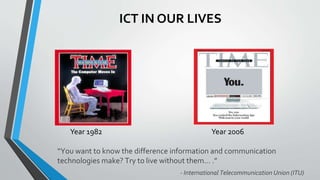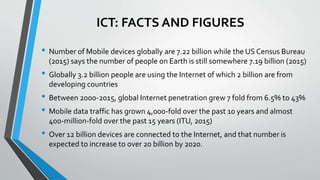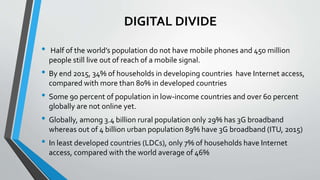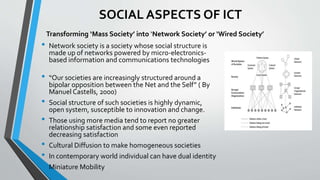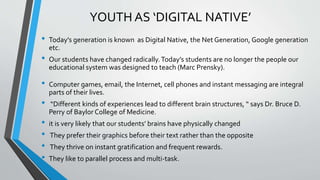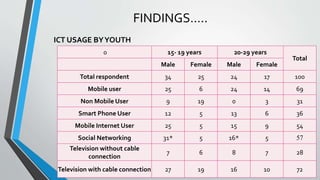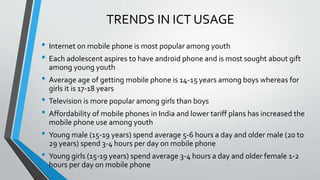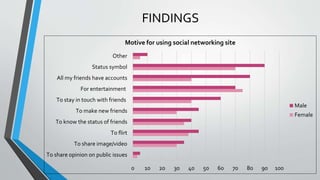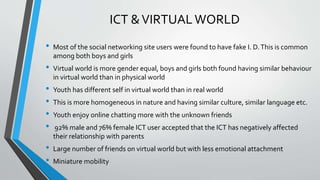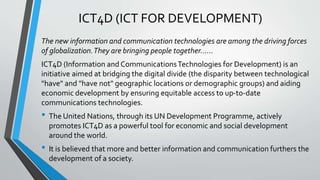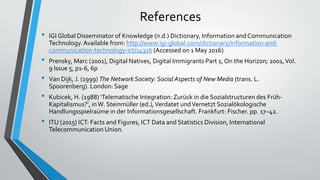ICT & Youth
- 1. YOUTH, ICT ANDTHE VIRTUALWORLD RUPALI AGARWAL (Commonwealth Scholar) M.Phil. (Sociology) & MPH
- 2. ICT IN OUR LIVES Year 1982 âYou want to know the difference information and communication technologies make? Try to live without themâĶ .â - International Telecommunication Union (ITU) Year 2006
- 3. MEANING OF ICT âĒ Information and Communication Technology (ICT) is an umbrella term that includes any means of storing, retrieving, transferring or communicating information digitally (IGI Global Dictionary)
- 4. ICT: FACTS AND FIGURES âĒ Number of Mobile devices globally are 7.22 billion while the US Census Bureau (2015) says the number of people on Earth is still somewhere 7.19 billion (2015) âĒ Globally 3.2 billion people are using the Internet of which 2 billion are from developing countries âĒ Between 2000-2015, global Internet penetration grew 7 fold from 6.5% to 43% âĒ Mobile data traffic has grown 4,000-fold over the past 10 years and almost 400-million-fold over the past 15 years (ITU, 2015) âĒ Over 12 billion devices are connected to the Internet, and that number is expected to increase to over 20 billion by 2020.
- 5. DIGITAL DIVIDE âĒ Half of the worldâs population do not have mobile phones and 450 million people still live out of reach of a mobile signal. âĒ By end 2015, 34% of households in developing countries have Internet access, compared with more than 80% in developed countries âĒ Some 90 percent of population in low-income countries and over 60 percent globally are not online yet. âĒ Globally, among 3.4 billion rural population only 29% has 3G broadband whereas out of 4 billion urban population 89% have 3G broadband (ITU, 2015) âĒ In least developed countries (LDCs), only 7% of households have Internet access, compared with the world average of 46%
- 6. DYSTOPIAN AND UTOPIANVIEWS ON ICT DystopianView (1980 to 1990) According to them, the new media were reducing, diminishing and even destroying the quality of face-to-face communications and were making relationships at work more formal (Kubicek, 1988).They would result in privacy reduction and total control from above. Utopian View (1990 to 2000) According to utopian views, the new media substantially improving the quality of life and of communication. A ânew economyâ and a new era of prosperity, freedom and online democracy was looming ahead. Syntopian View (2000 onwards) This is more balanced view on ICT based on facts, empirical investigations and learning gained from past experience.
- 7. SOCIAL ASPECTS OF ICT âĒ Network society is a society whose social structure is made up of networks powered by micro-electronics- based information and communications technologies âĒ âOur societies are increasingly structured around a bipolar opposition between the Net and the Selfâ ( By Manuel Castells, 2000) âĒ Social structure of such societies is highly dynamic, open system, susceptible to innovation and change. âĒ Those using more media tend to report no greater relationship satisfaction and some even reported decreasing satisfaction âĒ Cultural Diffusion to make homogeneous societies âĒ In contemporary world individual can have dual identity âĒ Miniature Mobility Transforming âMass Societyâ into âNetwork Societyâ or âWired Societyâ
- 8. VIRTUAL WORLD Virtual communities are associations of people not bound to time, place and physical or material circumstances. They are created in electronic environments with the help of mediated communications. âĒ Blurred public-private distinction âĒ Time- Space Distantiation: Expension and Compression of time and space âĒ Generalization and a standardization of social environments. âĒ Socialization of individual space.
- 9. YOUTH AS âDIGITAL NATIVEâ âĒ Todayâs generation is known as Digital Native, the Net Generation, Google generation etc. âĒ Our students have changed radically.Todayâs students are no longer the people our educational system was designed to teach (Marc Prensky). âĒ Computer games, email, the Internet, cell phones and instant messaging are integral parts of their lives. âĒ âDifferent kinds of experiences lead to different brain structures, â says Dr. Bruce D. Perry of Baylor College of Medicine. âĒ it is very likely that our studentsâ brains have physically changed âĒ They prefer their graphics before their text rather than the opposite âĒ They thrive on instant gratification and frequent rewards. âĒ They like to parallel process and multi-task.
- 10. RESEARCH STUDY ResearchTopic:Youth, ICT and theVirtualWorld: Sociological Study in a Resettlement Colony of Delhi Objective: 1. Examine the nature and extent of ICT usage by the youth. 2. Understand ICT as a tool in construction of identity by the youth. 3. Assess gender and age based segregated influence of ICT on youth in a resettlement colony. 4. Examine ICT as means of social inclusion/exclusion for the youth. 5. Explore the process of construction of virtual community through the ICT and the position of youth in it. âĒ Research Methodology: Qualitative ResearchApproach âĒ Sample Size: 100Youth (15 to 29 years of age) ; 58 male and 42 female
- 11. FINDINGSâĶ.. ICT USAGE BYYOUTH 0 15- 19 years 20-29 years Total Male Female Male Female Total respondent 34 25 24 17 100 Mobile user 25 6 24 14 69 Non Mobile User 9 19 0 3 31 Smart Phone User 12 5 13 6 36 Mobile Internet User 25 5 15 9 54 Social Networking 31* 5 16* 5 57 Television without cable connection 7 6 8 7 28 Television with cable connection 27 19 16 10 72
- 12. TRENDS IN ICT USAGE âĒ Internet on mobile phone is most popular among youth âĒ Each adolescent aspires to have android phone and is most sought about gift among young youth âĒ Average age of getting mobile phone is 14-15 years among boys whereas for girls it is 17-18 years âĒ Television is more popular among girls than boys âĒ Affordability of mobile phones in India and lower tariff plans has increased the mobile phone use among youth âĒ Young male (15-19 years) spend average 5-6 hours a day and older male (20 to 29 years) spend 3-4 hours per day on mobile phone âĒ Young girls (15-19 years) spend average 3-4 hours a day and older female 1-2 hours per day on mobile phone
- 13. TIME SPENT IN WATCHINGTELEVISION 0 1 2 3 4 5 6 14 15 16 17 18 19 20 21 22 23 24 25 26 27 28 Per day time in watchingT.V. Age Boys Girls
- 14. FINDINGS 0 10 20 30 40 50 60 70 80 90 100 To share opinion on public issues To share image/video To flirt To know the status of friends To make new friends To stay in touch with friends For entertainment All my friends have accounts Status symbol Other Motive for using social networking site Male Female
- 15. ICT & PEER CULTURE âĒ Gazettes as Status Symbol âĒ ICT usage helps in boosting Self-Confidence & autonomy âĒ ICT usage helps in creating self-image & personality development âĒ Facilitate developing love relationships at younger age âlove onlineâ âĒ ICT is more a means of entertainment and to remain connected with the peers âĒ ICT use increases the sense of power among male youth âĒ Pornography through mobile internet is very common among youth.The average age of watching pornography among male is 14 years. Similar behaviour is found among girls as well, however with increased age (16 to 19 years) âĒ There is trend to have unknown friends on Social networking sites like Facebook, âMobile initimacyâ
- 16. ICT &VIRTUALWORLD âĒ Most of the social networking site users were found to have fake I. D.This is common among both boys and girls âĒ Virtual world is more gender equal, boys and girls both found having similar behaviour in virtual world than in physical world âĒ Youth has different self in virtual world than in real world âĒ This is more homogeneous in nature and having similar culture, similar language etc. âĒ Youth enjoy online chatting more with the unknown friends âĒ 92% male and 76% female ICT user accepted that the ICT has negatively affected their relationship with parents âĒ Large number of friends on virtual world but with less emotional attachment âĒ Miniature mobility
- 17. ICT4D (ICT FOR DEVELOPMENT) The new information and communication technologies are among the driving forces of globalization.They are bringing people togetherâĶ... ICT4D (Information and CommunicationsTechnologies for Development) is an initiative aimed at bridging the digital divide (the disparity between technological "have" and "have not" geographic locations or demographic groups) and aiding economic development by ensuring equitable access to up-to-date communications technologies. âĒ The United Nations, through its UN Development Programme, actively promotes ICT4D as a powerful tool for economic and social development around the world. âĒ It is believed that more and better information and communication furthers the development of a society.
- 18. ICT & SDGs âĒ GDP could be boosted by 12% in developing countries if broadband penetration reached 80% in 2030, up from 44.5% in 2014 âĒ By catalyzing SDG achievement, the ICT sector could potentially earn up to USD 2.1 trillion in revenue by 2030 âĒ Carbon emissions could be reduced by 12% from âbusiness as usualâ scenario by implementing digital solutions âĒ Road traffic accidents could be reduced by 60% through smart mobility Youth is not only the future, youth is also the present, and the most powerful weapon to build a better world by 2030 (UN)
- 19. References âĒ IGI Global Disseminator of Knowledge (n.d.) Dictionary, Information and Communication Technology.Available from: http://www.igi-global.com/dictionary/information-and- communication-technology-ict/14316 (Accessed on 1 May 2016) âĒ Prensky, Marc (2001), Digital Natives, Digital Immigrants Part 1, On the Horizon; 2001,Vol. 9 Issue 5, p1-6, 6p âĒ Van Dijk, J. (1999) The Network Society: Social Aspects of New Media (trans. L. Spoorenberg). London: Sage âĒ Kubicek, H. (1988) âTelematische Integration:ZurÞck in die Sozialstructuren des FrÞh- Kapitalismus?â, inW. SteinmÞller (ed.),Verdatet undVernetzt SozialÃķkologische HandlungsspielraÞme in der Informationsgesellschaft. Frankfurt: Fischer. pp. 17â42. âĒ ITU (2015) ICT: Facts and Figures, ICT Data and Statistics Division, International Telecommunication Union.
Editor's Notes
- #3: Time is an American weekly news magazine, it has the world's largest circulation for a weekly news magazine, and has a readership of 26 million, 20 million of which are based in the United States In 1982, the Timeâs Magazine âPerson of the Yearâ award was given to nonhuman that was the computer. Then later in 2006 again the computer got place in the Timeâs magazine but this time it was an individual inside the computer. These are symbolic and reflect the changing identity of human being in the virtual world and how the world of ICT is expanding itself to bring human inside its ambit. âwe live in a connected worldâ, âa connected ageâ, a âhuman webâ and a âweb societyâ
- #6: Digital divide is a term that refers to the gap between demographics and regions that have access to modern information and communications technology, and those that don't or have restricted access. This technology can include the telephone, television, personal computers and the Internet.
- #8: Allocution: the simultaneous distribution of information to an audience of local units by a centre that serves as the source of, and decision agency for, the information (in respect of its subject matter, time and speed) eg. Pay-per-view Consultation: Consultation* is the selection of information by (primarily) local units, which decide upon the subject matter, time and speed, at a centre which remains its source. Eg. CD-ROM, DVD, Cable TV Registration: Registration* is the collection of information by a centre that determines the subject matter, time and speed of information sent by a number of local units, who are the sources of the information and sometimes take the initiative for this collection themselves (to realize a transaction or reservation). Eg. Electronic reservation, teleshopping, telebanking
- #9: The mass society can be defined as a social formation with an infrastructure of groups, organizations and communities (âmassesâ) shaping its prime mode of organization at all levels (individual, group/organizational and societal). The basic units of this formation are all kinds of relatively large collectivities (masses) organizing individuals. NS an organization of society based on science, rationality and reflexivity; âĒ an economy with all values and sectors, even the agrarian and industrial sectors, increasingly characterized by information production; âĒ a labour market with a majority of functions largely or completely based on tasks of information processing requiring knowledge and higher education (hence, the alternative term knowledge society); âĒ a culture dominated by media and information products with their signs, symbols and meanings. information has become an independent source of productivity and power.
- #10: basic unit of the network society has become the individual who is linked by networks There is much talk about the death of distance and the 24-hour economy. Modern societies stretch further and further across time and space. Barriers of time are broken by the spread of customs or traditions. Information is stored to be used later or to be passed on to future generations. Barriers of space are broken by the increasing reach of communication and transportation. Death of distance, Tiemless time
- #13: the age-group of 15-29 years, which constitutes 27.5 percent of the population according toĖýCensus-2011, which is about 33 crore persons.
- #21: The 17 goals are very ambitious, aiming to end poverty, extreme hunger, ensure quality education for everyone, improve healthcare, end gender inequality, protect, restore and promote sustainable use of ecosystems, etc. to improve social and economic development and end inequality.


